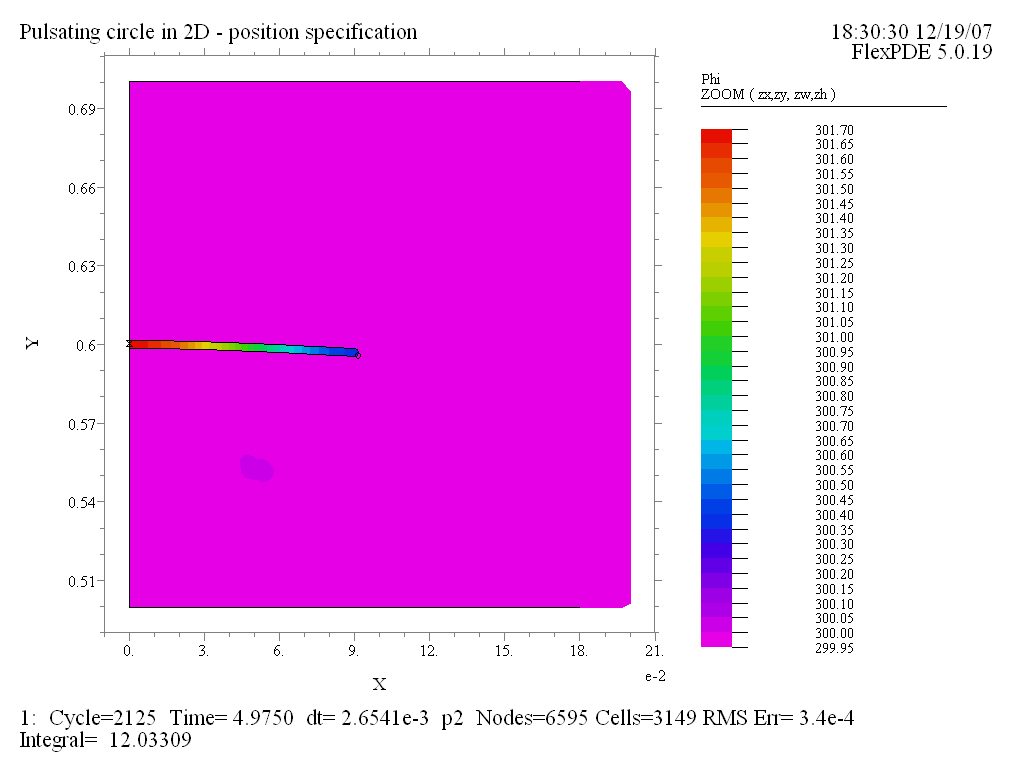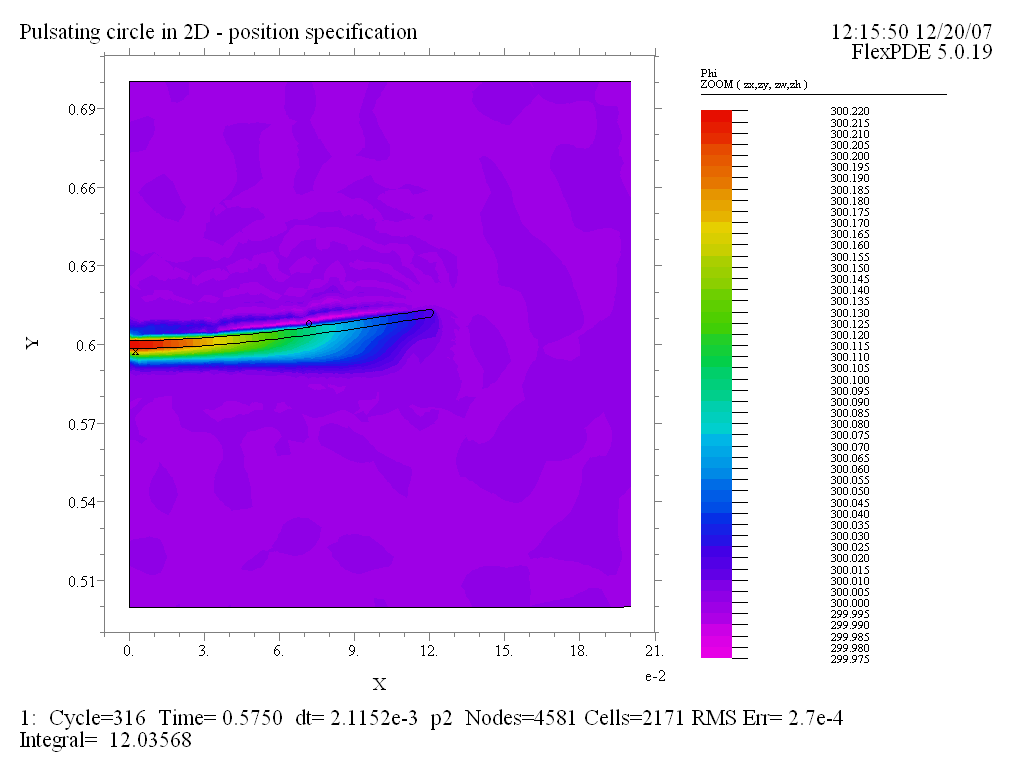| Author | Message | |||
Mehdi Naderi (mnader4) Member Username: mnader4 Post Number: 26 Registered: 12-2006 |
Dear Mr. Nelson, I will appreciate if you answer my question. As you know, I modeled a fluctuated beam with moving mesh. In that problem I assumed surface temperature on the beam. But now I want to solve the conduction inside the beam simultaneously. I wrote the program it does not work. I think fpde solves all the equtions of the domain. How can I limit fpde to solve one of the equation in a specific domain? Can fpde solve just heat conduction inside the beam and just fluid around the beam? Regards, Mehdi
| |||
Marek Nelson (mgnelson) Moderator Username: mgnelson Post Number: 6 Registered: 07-2007 |
Could you post the script file? (.pde) | |||
Mehdi Naderi (mnader4) Member Username: mnader4 Post Number: 27 Registered: 12-2006 |
Dear Mr. Nelson, The attached file is the script. (to get the zero velocity inside the beam I assume a very large viscosity) Maybe the boundary condition is not real I have to work on B.C. But It can be a first try to see how can Fpde can solve a specific equation for specific domain. Regards, Mehdi
| |||
Robert G. Nelson (rgnelson) Moderator Username: rgnelson Post Number: 1007 Registered: 06-2003 |
The present version of FlexPDE requires that all variables exist and be defined by PDE's everywhere in the domain. The further assumption is made (as a result of placing mesh nodes on the cell boundaries) that the variable values are continuous across material boundaries. This is the most common circumstance in physical problems, so no violence is usually done by these assumptions. In your case, it would be strange if the fluid had zero heat conductivity and did not affect the vane temperature. Furthermore, the vane is moving, so there are velocities in the vane. It is common to impose fluid velocities equal to the wall velocity as well (usually zero, but not in your case). So continuity of velocities should not be a problem. So, I'm not clear on why you want to delete some variables from some regions. Nevertheless, there is a facility for doing this, using the CONTACT boundary condition. The model implemented by this facility is, as the name implies, the contact resistance phenomenon at material interfaces. The CONTACT boundary condition defines a boundary flux between regions that depends on a surface resistance and the "JUMP" in the value of a variable. By imposing a very large resistance, the fields on the two sides of the boundary are effectively decoupled. (See "Jump Boundaries" or "CONTACT boundary conditions" in the Help Index.) You still have to provide equations for the entire domain, but you can set up the parameters and boundary conditions to force whatever values you want in the "absent" regions. Incidentally, your variable "ht" is simply an arithemetic definition, not a PDE. You don't need to (and shouldn't) make it a variable. | |||
Mehdi Naderi (mnader4) Member Username: mnader4 Post Number: 28 Registered: 12-2006 |
Dear Mr. Nelson, In my case, it is meaniningless to solve fluid equations inside the beam and also,solving heat conduction equation in the air. So, I asked to know fpde can solve just heat conduction inside the beam. There is a large source term inside the beam, so I should avoid solving heat conduction in the air). The aim of my sample is to caculate heat transfer coefficent of air while the beam fluctuating. if I use contact BC, I have to write: contact(temp)=1/R*jump(temp) on the boundaries. But,in my case, I have two sepeate variables for temperaure with different equation(phi for air ad Temp to inside the beam). I think contact BC is for the same variable. How can I apply contact BC in this case? What resistance should I choose (R?)? Is it necessary to write contact BC on both region? when will you add the ability that fpde can solve the specific equation for specific region (next version?)? Best Regards, Mehdi | |||
Robert G. Nelson (rgnelson) Moderator Username: rgnelson Post Number: 1009 Registered: 06-2003 |
I can see that you find it morally reprehensible to compute a value in a place you do not believe it to exist. But life is full of compromises. Just fix your plots so they don't plot the offensive values, and you can pretend they aren't there. I suggest you use the same variable for temperature inside the beam and in the air. I believe this is the way God does it. Using a JUMP condition, you can either connect them (as in the real world) or dissociate them (as in your mind) as you wish. Write the PDE with all the terms for both regions (presumably a diffusion and a transport term) and use REGIONAL parameter values to turn things off and on. Even though we do not believe this process to be onerous, we have included the ability to exclude variables from some regions in our capabilities list for version 6. No release date has been set for v6. | |||
Mehdi Naderi (mnader4) Member Username: mnader4 Post Number: 30 Registered: 12-2006 |
Dear Mr. Nelson, Thank you for your help. I changed the program (the attached file). But the running time is very very slow. I do not know I made a mistake in contact BC or not. Also this is a very course mesh. I need a fine mesh in the future. I am using a trail version and my time is going to end. I have to decide that fpde can solve my problem or not. I will appreciate if you help me. Regards, Mehdi
| |||
Robert G. Nelson (rgnelson) Moderator Username: rgnelson Post Number: 1014 Registered: 06-2003 |
Something is very sick in your script. It gets to about t=0.02 and ties itself in a knot, then grinds into oblivion. Attached is a modification of the file I sent you earlier, in which I have added the temperature calculation in the bar. It does not try to decouple the bar from the fluid. It runs nicely, completing a full cycle of the bar in about 1/2 hour. When time permits, I will try to add the decoupling (although I don't understand why one would want to do that).
| |||
Robert G. Nelson (rgnelson) Moderator Username: rgnelson Post Number: 1016 Registered: 06-2003 |
It appears that I posted the wrong file last time (Right name, wrong folder).... I think this is the right one.
| |||
Robert G. Nelson (rgnelson) Moderator Username: rgnelson Post Number: 1022 Registered: 06-2003 |
Here is a version of your script with the temperature in the bar isolated from the fluid using CONTACT. I have defined the parameter FLUID, with value 0 or 1. This parameter turns on and off the fluid terms in the equations. I have also made a dense mesh surrounding the bar, rounded the end of the bar and separated the bar outline from the chamber outline. I did not attempt to correct the x positions of the bent bar. Also, it appears that your original inclination to apply a very large threshold to P was the right one. P goes through some violent changes as the bar sweeps back through the vortex. Applying timestep controls to the changes of P restricts the timestep to ridiculously small values. I set the P Threshold to 10. Even with a relaxed P threshold, the problem still runs a long time. The collision of the bar with the vortex takes time to resolve. The attached GIF file shows the fluid speed for six oscillations of the bar. It took 84 hours to run (at 1.5Ghz). This might be reduced with a smaller penalty on the pressure equation, and/or with a coarser mesh.
 | |||
Mehdi Naderi (mnader4) Member Username: mnader4 Post Number: 38 Registered: 12-2006 |
Dear Mr. Nelson, Thank you for your help. I am still working on this problem. The program also solves temperature inside and outside of the beam. The attached file shows temeprature distribution after 10 cycle. But unfortunately there is no even a little bit temperature variation around the beam (also, I saw -k*grad(phi) but there was no flux from beam boundary to the air). I think the interface boundary does not work truly. In the last file you changed it to contact(phi)=0*jump(phi) I think 1/R=0 decouples the phi in two regions. There should be a little diffusion of heat to the air. I will apprecitae if you let me know how I can change the interface boundary to see the flux of heat to the air. Regards, Mehdi  | |||
Robert G. Nelson (rgnelson) Moderator Username: rgnelson Post Number: 1034 Registered: 06-2003 |
Yes, "contact(phi)=0*jump(phi)" completely decouples the bar from the fluid. That's what I meant when I said "Here is a version of your script with the temperature in the bar isolated from the fluid using CONTACT." I have no idea what the correct coupling should be, so I made it zero. You are free to put in what you think is the right resistance. | |||
Mehdi Naderi (mnader4) Member Username: mnader4 Post Number: 39 Registered: 12-2006 |
Dear Mr. Nelson, Thank you. I changed it to contact(phi)=100000*jump(phi)" , a large number. it meanse that the contact resistance between solid and air is very small. Do you think this assumption is true? Below shows the reult up to now:  | |||
Robert G. Nelson (rgnelson) Moderator Username: rgnelson Post Number: 1036 Registered: 06-2003 |
1. With such a small resistance, I would guess you don't need a CONTACT boundary at all. If you leave it out, the bar and fluid will be at the same temperature on the boundary, and the flux will be determined by the conductivity of the fluid. Your picture above does not display any significant offset of contour lines at the interface. 2. In some experiments with this problem, it appears that it runs faster if you use SELECT TORDER=1. This selects a first-order time integration scheme (backward Euler), which is less accurate over large timesteps, but less prone to oscillation. Since the violence of the velocities when the bar sweeps back through the vortex holds the timestep very small, TORDER=1 is probably not measurably different from the default TORDER=2. Experiment could validate this guess. Experiment should also be done to determine the best value for the pressure penalty. |